Article Archive
Aesop
Hwyl
1 December, 2017
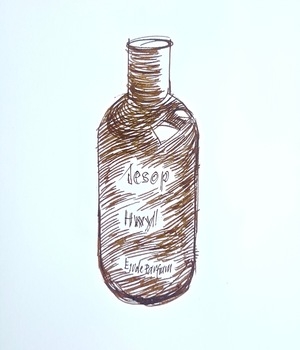 Since 2004, when its first store opened in the corner of a Melbourne car-park, Aesop has developed into a global brand, thanks to its simple but sensual products, individually designed boutiques and large injections of private capital (most recently from Natura Cosméticos, the Brazilian version of Avon, which took full control of the brand in 2016).
Since 2004, when its first store opened in the corner of a Melbourne car-park, Aesop has developed into a global brand, thanks to its simple but sensual products, individually designed boutiques and large injections of private capital (most recently from Natura Cosméticos, the Brazilian version of Avon, which took full control of the brand in 2016).
Given that fragrance was always part of its products’ appeal (founder Dennis Paphitis got the original idea after adding essential oils to hair bleach to disguise the smell of ammonia), it’s no surprise that Aesop has flirted with perfume over the years. In 2005 it launched Marrakech, followed by Mystra in 2006, both of which were subsequently discontinued, though they still have their fans – perfumer Paul Schutze still has his roller-ball version of Marrakech, which he suspects was a commercial disaster not because of the fragrance, which he loves, but because ‘you use so little scent with the roller-ball that you never need to buy another one’.
In 2014 Aesop returned to perfume with Marrakech Intense, followed by Tacit in 2015 and now, in 2017, Hwyl. Though the name is Welsh, the scent is inspired by smoke floating through a Japanese forest of hiba cypress trees (the conifer Thujopsis dolabrata, also known as Hiba arborvitae), and that’s pretty much what you smell when you first put it on. The formula, which was devised by French perfumer Barnabé Fillion (who previously contributed to Marrakech Intense), also includes a good dose of thyme with hints of spice, moss and vetiver.
Hywl is my favourite of the three ‘new’ Aesop perfumes so far, though I think it’s rather overpriced at £83 for 50ml, especially as it doesn’t last for more than two or three hours on my skin (Aesop kindly sent me a bottle to review). It enters an increasingly crowded field of perfumes based around the smells of incense and smoke, most of them aimed at men, and while it’s nice of its kind, I can’t say that it’s especially original. But then perhaps Aesop knows that its customers aren’t looking for ground-breaking scents: just something that’s easy to wear and fairly on-trend, which Hwyl certainly is.
Haeckels
GPS 26′ 3″E and GPS 12′ 0″E
26 October, 2017
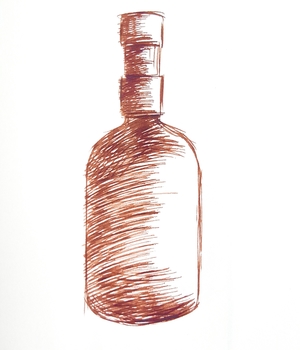 ‘Made in Margate’ is not a phrase you often see on perfume bottles, which is one reason Haeckels has garnered plenty of attention. The brainchild of Dom Bridges, a graphic designer and film director who used to make commercials for the likes of Lucozade and Pot Noodles, it was launched in 2012 after he and his wife moved to washed-up-and-coming Kentish seaside town of Margate and he was looking around for something to do.
‘Made in Margate’ is not a phrase you often see on perfume bottles, which is one reason Haeckels has garnered plenty of attention. The brainchild of Dom Bridges, a graphic designer and film director who used to make commercials for the likes of Lucozade and Pot Noodles, it was launched in 2012 after he and his wife moved to washed-up-and-coming Kentish seaside town of Margate and he was looking around for something to do.
Haeckels’ first products were soaps made with seaweed from the beach, and while Bridges has branched out into skincare and perfume since then, the raw ingredients (apart from some of the essential oils used in the perfumes) and packaging still come from within a twenty-mile radius of Margate. It’s a great back story, and the design – both of the products and the appealingly hand-crafted Haeckels shop – are a testament to Bridges’ creative and visual talents.
Each perfume is inspired by the scents of specific sites near Margate, and is (not very memorably) named after the GPS coordinates for that spot. They come in brown apothecary bottles with heavy brass tops that looks like bits of plumbing, and each is foam-packed in a wood-veneer box, the sliding lid perforated with its matching GPS numbers. You also get an information card and a rectangular stick of chalk, which you can spray with scent and use as a room-diffuser – a clever touch that also references the white chalk cliffs of Kent.
All of which I love – but what about the fragrances themselves? I’ve tried two: GPS 26′ 3″E and GPS 12′ 0″E. The first, ‘Picked on 1 August 2014. Cloudy day’ according to the website, is inspired by the chalk clifftops of Botany Bay in Broadstairs, an attractively frayed-round-the-edges little seaside resort much favoured by Charles Dickens and London cab drivers. Bridges describes the bay’s beauty as ‘shown best on days when it rains, as the rain hits the chalk a fresh and clear fragrance come off the rock to give way to the freshness of cliff grasses, annual seablite and sea orache.’
I certainly get the freshness, but what it smells like most to me is blackberry – that quintessential late-summer scent of English hedgerows and wasteland, with a hint of the other ingredients mentioned on the Haeckels website: bergamot oil, cinnamon and lavender. It’s a pleasant enough scent, if not in any way original, and reminds me a little of L’Artisan Parfumeur’s classic Mure et Musc.
The other, GPS 12′ 0″E, is oddly similar, again with a hint of autumn fruitiness, though this time mixed with a longer and more complex run of ingredients, including bergamot and mandarin oil, rosemary and lavender, rose and olibanum, fir balsam and even turpentine – which perhaps accounts for its slightly medicinal smell. This perfume is inspired by the ruined Roman castle at Reculver, further west along the Kent coast, which (completely incidentally) was the first place in England I heard a nightingale sing.
Bridges describes his inspiration for the fragrance in some detail, also noting that it was picked on 23 July 2014, a sunny day. ‘With waves smashing into the sea defences below sits a ruined abbey, graveyard and wild, overgrown fields. Remnants of more recent uses are now overgrown and covered over with blackberries, raspberries and sea lavender. The salt water spraying up onto the path and the grass leaves small puddles so that the smell of the sea is carried by the wind to mix with the berries, flowers and wild parsley to create a fragrance that is fresh, but shows the history that surrounds this place in every direction.’
I wish I could like these perfumes more, since everything else about Haeckels is so appealing. It’s not that they’re bad: far from it – they’re pleasant enough, just not very interesting or original, which would be fine if they didn’t cost £160 each.
Guerlain
Habit Rouge
27 April, 2015
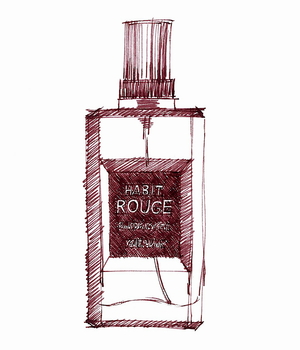 ‘Mass luxury’ may be the oxymoron of the moment, but the name of Habit Rouge is a nod back to a time when perfume really was a luxury enjoyed only by the stinking rich (eg the family Guerlain), among whom fox-hunting was a favourite pursuit.
‘Mass luxury’ may be the oxymoron of the moment, but the name of Habit Rouge is a nod back to a time when perfume really was a luxury enjoyed only by the stinking rich (eg the family Guerlain), among whom fox-hunting was a favourite pursuit.
Habit Rouge, in this context, is the French term for what British toffs call (with typical bourgeois-baiting mystification) ‘hunting pinks’, the scarlet riding jackets worn while hunting the fox. But that’s as far as the hunting or riding references go, which is probably a good thing, if you know what an actual fox or a horse-stable smells like.
Created by the last of the great Guerlain family perfumers, Jean-Paul, and launched in 1965, Habit Rouge was only the third Guerlain fragrance to be aimed at men. In character it is very different from its immediate predecessor, Vetiver, launched in 1959. While Vetiver is elegantly earthy (a brilliant contradiction in terms) and ineffably masculine, Habit Rouge is much more dandified, with a sharp, powdery sweetness that some people love but that makes others gag – imagine lemon sherbert in liquid form and you won’t be far wrong.
According to my friend the perfumer Roja Dove (who worked at Guerlain for twenty years), it ‘has an extraordinary volume of hesperidic materials, especially bergamot and lemon, which make up in excess of 25 per cent of the formula. Without question you can “feel” their effervescence.’It’s so zingy to start with that I wonder whether it might even contain a touch of aldehydes – the chemicals that give Chanel No. 5 its champagne fizz.
With all that lemon you’d imagine it would smell like an eau de cologne, but like other classic Guerlain perfumes Habit Rouge has great depth and complexity, and in the terminology of the perfume world it actually counts as an ‘oriental’-style fragrance, as behind the sherbert there’s a surprising amount of spice as well.
Though the version we have today was apparently ‘cleaned up’, as the industry jargon has it, by another fine perfumer, Edouard Fléchier, to comply with updated regulations governing the use of potentially harmful ingredients, it still smells wonderfully rich, with traces of vanilla and patchouli for those who smell it carefully.
Habit Rouge also lasts and lasts, which for me is an added plus when a perfume is as great as this – for anyone on a limited budget it’s hard to justify spending £70 or so on something that vanishes within an hour of putting it on. Definitely worth hunting down.
Guerlain
L’Homme Idéal
11 October, 2014
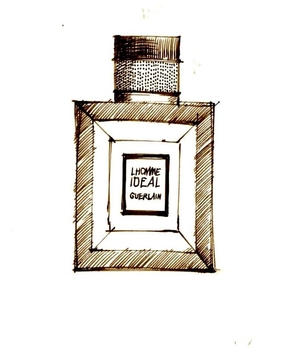 I have before me a bottle of Amaretto liqueur, which I’m tempted to drink, though seeing as it’s ten in the morning I probably shouldn’t. I also have a bottle of the latest men’s perfume from Guerlain, L’Homme Idéal, which you’ll be relieved to hear I won’t be drinking either.
I have before me a bottle of Amaretto liqueur, which I’m tempted to drink, though seeing as it’s ten in the morning I probably shouldn’t. I also have a bottle of the latest men’s perfume from Guerlain, L’Homme Idéal, which you’ll be relieved to hear I won’t be drinking either.
The reason for this conjunction is that several reviews of L’Homme Idéal have suggested that it smells distinctly like Amaretto, so I’m testing whether they do – and the answer is that, side by side like this, they don’t. Amaretto smells far sweeter and more almondy, with a touch of bitter almonds that L’Homme Idéal lacks.
All the same, the Amaretto comparison should give you some idea of L’Homme Idéal’s character: burnt-sugar sweet and, yes, really quite almondy. It’s a smell that won’t appeal to every man (though I suspect a lot of women will like it), and in fact the perfume hasn’t exactly been greeted with universal acclaim, though personally I rather like it.
Launched in June 2014, L’Homme Idéal was created by Thierry Wasser, who has been the company’s in-house perfumer since 2008; I’ve reviewed one or two of his other perfumes, including Guerlain Homme l’eau Boisée and the wonderfully refreshing Cologne du Parfumeur. Its ingredients include orange, rosemary, cedar and vetiver, but the two that most people pick up on are tonka beans and almonds, with a bit of leather thrown in.
Tonka beans are used in a wide range of perfumes, and they have a warm, slightly sweet smell, which many people find reminds them of food, especially chocolate and vanilla. The scent of almonds is less often used (though James Heeley’s fine but painfully overpriced L’Amandière smells of almost nothing else), but they’re what give L’Homme Idéal its distinctly foody, burnt-sugar smell.
Luckily – from my point of view at least – L’Homme Idéal isn’t nearly as sickly-sweet as Thierry Mugler’s revolting Angel, or even as cutesy sweet as Black XS for Men from Paco Rabanne. Sweet smells, like sweet tastes, have something a bit childlike and unsophisticated about them, but Thierry Wasser has toned the sweetness down here by surrounding the tonka beans and almonds with the smells of freshly-sawn wood and new leather, as well as a hint of dry, earthy vetiver.
All in all this is a nice enough fragrance, but it’s a bit too muted and polite to really stand out for me. That may well be intentional, since it seems to be squarely aimed at the big middle market, whose buyers are not widely considered to be particularly adventurous or sophisticated. Mind you they’re also considered to be virtually illiterate, if Guerlain’s French-pretentious marketing guff is anything to go by.
Yes, it’s same old tired perfume bollocks yet again: ‘The ideal man is a myth. His fragrance, a reality. Guerlain decodes men’s aspirations and creates for them a concentrate of ideal. The ideal fragrance? Smart, handsome, strong. Three adjectives, three accords for this fresh woody fragrance that will trigger your full potential.’ As a copywriter myself I’d be ashamed to have written that, though I’m sure whoever did write it was handsomely paid. (The box, incidentally, sports a typographical car-crash that seems to read, ‘Be You. No Need to Anymore Have Your Fragrance.’ Got that? Me neither.)
Still, the smell is nice enough, and the bottle is actually far better than most: a chunky glass square with (according to Guerlain) ‘radical’ matt black lacquer sides and a crisply detailed cap that apparently ‘borrows its guilloché detailing from the world of watchmaking.’ I think they should have borrowed the cap from an Amaretto bottle, but there you go.
Lalique
Hommage à l’homme
29 April, 2014
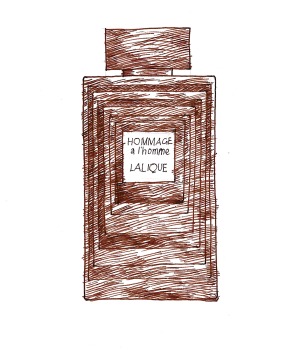 Now here’s a tough one. Hommage à l’homme was the first perfume I reviewed whose London launch I attended and whose creator I met, but it’s also the first perfume I reviewed that I didn’t actually enjoy.
Now here’s a tough one. Hommage à l’homme was the first perfume I reviewed whose London launch I attended and whose creator I met, but it’s also the first perfume I reviewed that I didn’t actually enjoy.
On the whole I dislike knocking things, and generally I’d rather not mention fragrances that do nothing for me, but given the number of new launches each year there are bound to be some duds, so if I’m going to recommend scents that appeal to me it seems only honest to come clean about the ones that don’t.
Lalique has a long association with perfume, going back to 1908, when the ground-breaking French perfumer François Coty commissioned René Lalique to design perfume labels for him. Soon Lalique was designing perfume bottles too, and over the decades the company became known for its innovative techniques and the superb quality of its workmanship.
It wasn’t until 1992, though, that Lalique launched a perfume of its own, the imaginatively named Lalique de Lalique. There are now 19 Lalique perfumes to choose from, and Hommage de l’homme is the fourth to be marketed for men.
Hommage de l’homme marks two decades of perfume production, so you’d hope it’d be something special. My problem is that – to me at least – it smells totally generic, and not in a good way. Yes, I can vaguely smell the violets and saffron that we’re told it contains, but they’re completely overpowered by the same toxic chemical smell that spoils so many otherwise promising men’s fragrances.
Ever since I first recoiled from my first sniff of Dior’s Higher in 2001, every other mainstream men’s fragrance seems to have been stuffed full of the same noxious ingredient, which gets right up my nose. It has a harsh, acrid odour, like you get when your computer blows up – a burnt-plastic smell that I wouldn’t want in a toilet cleaner, never mind a perfume I might spray on my skin.
I’ve been puzzling what this secret component could be, if only so I could avoid it – could it be some kind of natural or synthetic extract of black pepper? Would someone like to tell me? Whatever it is, for me it’s a trend that, like Ugg boots, has long outlasted its welcome. Please, perfumers, move on.
PS: Finally someone has identified it: the much-appreciated Grooming Guru, Lee Kynaston – now we know!